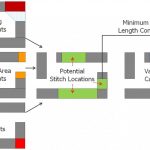“Now, here, you see, it takes all the running you can do, to keep in the same place. If you want to get somewhere else, you must run at least twice as fast as that!”
—Lewis Carroll, Through the Looking Glass
The use of stitching can greatly reduce the number of double patterning (DP) decomposition violations that a designer has to resolve.… Read More
Electronic Design Automation
Two New TSMC-Cadence Webinars for Advanced Node Design
Foundries and EDA vendors are cooperating at increasing levels of technical intimacy as we head to the 20nm and lower nodes. Cadence has a strong position in the EDA tools used for IC design and layout of custom and AMS (Analog Mixed-Signal) designs. They have created a series of webinars to highlight the design challenges and new… Read More
FinFETs: Ask the Experts!
On Friday (April 19[SUP]th[/SUP]) I will be keynoting FinFET day at the EDPS conference in Monterey. This is an excellent opportunity to ask the experts about the challenges of FinFET design and manufacturing in an intimate setting (60 people). If you are interested register today and use the promo codeSemiWiki-EDPS-JFR and … Read More
3D IC: Are We There Yet?
For the last few years, thru silicon via (TSV) based ICs have been looming in the mist of the future. Just how far ahead are they? Xiliinx famously has a high-end gate-array in production on a 2.5D interposer, Micron has a memory cube, TSMC has done various things in 3D that it calls CoWoS (chip on wafer on substrate), Qualcomm have been… Read More
TSMC Responds to Samsung!
This was the 19[SUP]th[/SUP] annual TSMC Symposium and by far the best I have attended. Finally tired of the misinformation that plagues our industry, TSMC set the record straight with wafer and silicon correlated data. TSMC shipped more than 88 MILLION logic wafers in 2012, more than any other semiconductor company, that gives… Read More
Berkeley Design Automation and the Cadence Legal Action!
SemiWiki broke the story yesterday about the Cadence legal action against Berkeley Design Automation and today I spent time with customers of both companies in Silicon Valley getting reactions. That is the advantage of working in Silicon Valley for almost 30 years, if you don’t know the right people, you certainly know the people… Read More
Mentor U2U, Not Your Father’s User Conference
I talked to Michael Buehler-Garcia about the changes Mentor is making to U2U, their user conference. It is in San Jose on April 25th at the DoubleTree.
Firstly, there are 3 great keynotes, two of whom I’ve seen speak before and can unreservedly recommend. Unfortunately I’m traveling that week and won’t be able… Read More
Cadence Sues Berkeley Design Automation
Cadence has brought a suit against Berkeley Design Automation for, as far as I can see, integrating their AFS circuit simulator with the Virtuoso Analog Design Environment (ADE) without using the (licensed) Oasis product. Since BDA is (actually was) a member of the Cadence Connections program, they have to abide by the contract… Read More
Manage your IC’s Stress for right performance
As we have moved towards lower process nodes to improve performance of ICs with higher density and functionality, many manufacturing effects have appeared which can render ICs useless, even though the layout design could be correct as per traditional design rules. What is more worrisome is the variability of these effects which… Read More
RTL Power Optimization
More so than most aspects of design, power reduction suffers from a paradox that early in the design cycle when the gains are the largest, the accuracy of power estimation is the lowest, and then late in the design cycle, when everything is known pretty much exactly it is too late to make anything other than trivial optimizations. … Read More












Website Developers May Have Most to Fear From AI